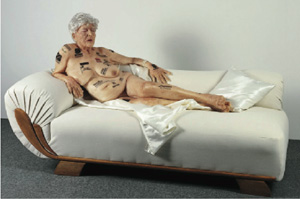
Vieille Femme aux Tatouages 2002
Gilles Barbier
Carré d'Art -Museé d'Art Contemporain
Place de la Maison Carrée in Nîmes, France
May 31st to September 17th, 2006
http://musees.nimes.fr/carreart/ac-carre.htm
By Joseph Nechvatal
http://www.nechvatal.net
Gilles Barbier’s remarkably ambitious exhibition at the Carré d'Art Museé d'Art Contemporain in Nîmes (Southern France) plays pithily with many current intellectual strands which interest me: net culture, artificial intelligence, image profusion, micro-organisms and science fiction (among others). But what struck me as most exact to its weird visual propositions was its deep reflection (one might even say brooding) on the theme of ignobility, and this grubbily shifted something in my head.
In this multi-gallery installation Barbier mixes frantically composed hand-made graphics - which display a mordantly witty obsession with language - and often wistfully perverse hyper-real sculptures. Immediately one feels his sense of dark humor - despite it being tied to a grueling work ethic. A peripatetic mind is clearly sensed behind such diverse, but hyper-linked, work - even while sensing an overall conveyance of longing connected to an acute awareness of death. If I may presume to decode such a wide range of ideas and styles used here, I would say that Barbier is attempting to give us a visual free verse for which we are unprepared, a visual sagacity that tests the limits of form and stretches the bounds of meaning by recasting our experiences of encountering wildly disjunctive data on the internet into the sumptuously physicality of negation.
Taken as a lapidary whole, Barbier’s work delivers this punch of negation by tying together methods of insouciant informality with a visceral camp irony: at turns hip and flamboyant - then turning towards the morally outrageous. Art here physically embodies the disappearing ephemeral we associate with electronically provided information today on the internet, and the flickering of its translucent form. Still the viewer is expected to work devotedly to solve the visual conundrums supplied here, to supply mental transitions between the diverse and massive assortment of graphics and sculptural elements (which supply the hooks). One must fabricate a complicated forensic story out of this grisly mélange, which keeps slipping in and out of idiosyncratic narration. And that recitation keeps turning back into one about stinking death, that strange incurable affliction. Humiliating death in all its undifferentiated fabulousness, by which I mean its essentially nasty comedy. Funny, difficult death then, which while pulling down our pants and revealing our soiled undies, keeps everyone laughing (or at least gurgling).
But also there is here an awareness of impertinent splendor in the tranquility of decomposition, which makes it all seem faintly heroic in face of death’s inexorability. We know of its putrid ignobility but will not give in. And this is what gives the work a strange sense of dignity, which asserts life’s primacy over death. Life, plus art, as paradox, because it is beyond narration and words.
So this is art which does not merely help us pass the time, but which enlivens it, if we surrender to its fearful difficulty. Barbier’s work here provides the chance to do the counter-fearful thing, to look at what we fear so that effort will help release us from fear’s grip. Then we can get over it and so enjoy life all the more. Then the ignobility of death can be ignored, and dignity restored – for now.